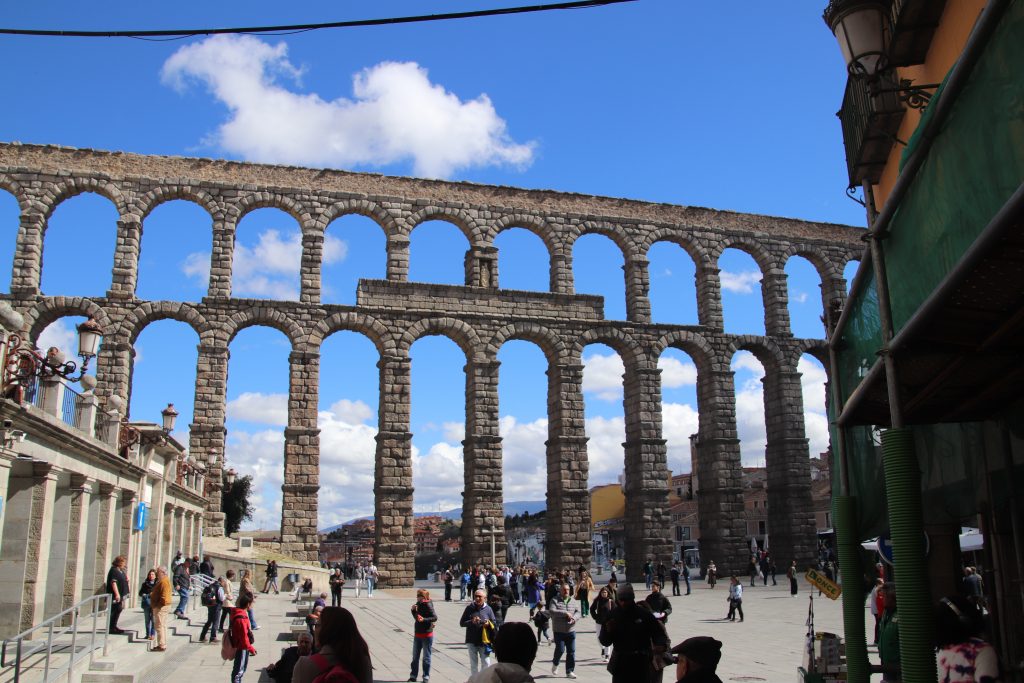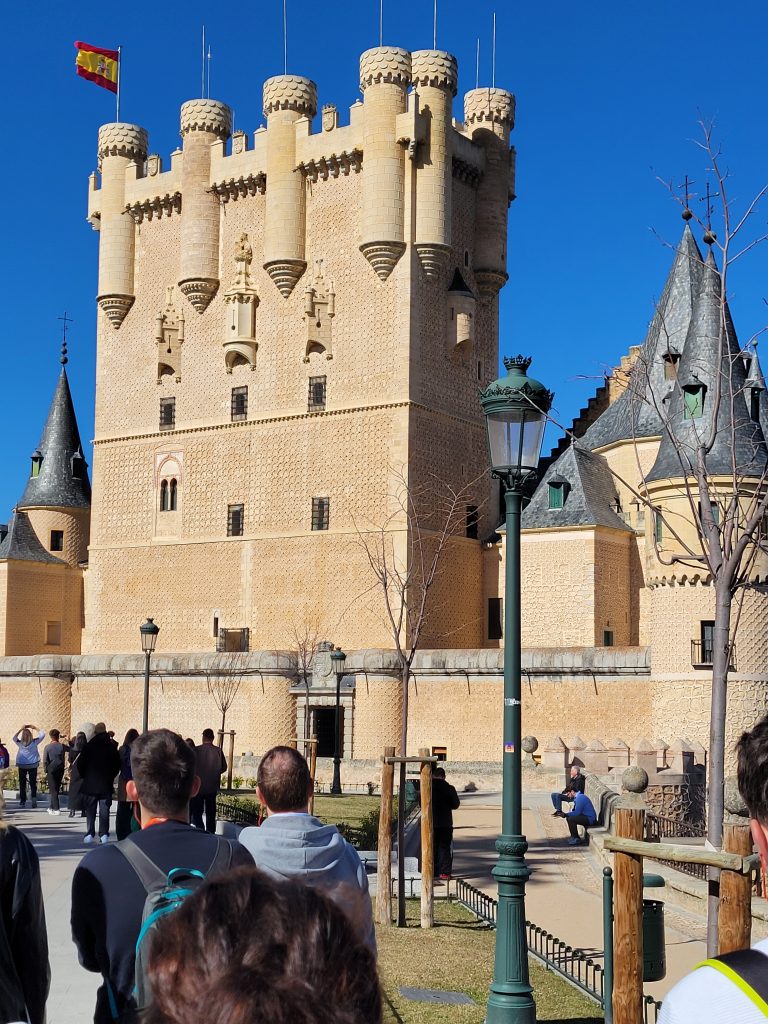On Thursday we spent all of our time in Madrid. On Friday, we went further afield, travelling all the way to Segovia and Avila.
We had breakfast outside on Thursday. It was cool, but sunny, and we were comfortable. The place we chose is right around the corner from our apartment. It was even a healthy breakfast. [I still haven’t had churros in Madrid.] We waited for it to warm up a little and then headed west in this part of town. We walked down Calle Mayor, past Plaza Mayor, toward La Catedral de Santa María la Real de la Almudena (Catedral de la Almudena). You would be forgiven for presuming that a church with such a grand name in such an old city as Madrid would itself be old. But it isn’t. The building was not begun until 1883. It is built in a sort of Gothic revival style which makes it seem older than it is but the inside is pretty modern. We visit the cathedral for the architecture and the stained glass. When we were here in 2020, all the gates were locked because of the pandemic and we could not get inside. This time, the church was not jam-packed, but it was busy.
After spending some time on the plaza between the church and the Royal Palace, we headed towards the opera house. That is a nice area which we hadn’t investigated too much on prior visits. We found our way easily because the buildings don’t move around much and, once I have been to a place, I can always usually find my way back. To get back to the apartment from there, we chose to go on streets we haven’t explored before. We, meaning Patricia, found lots of places to go back to for shopping. Our roundabout way back took us past a candy store I was unable to resist. For once, our roles were reversed: Patricia waited outside while I did the shopping.
We had tickets for a flamenco performance Thursday so we were going to have an early dinner. “Early” here seems to mean anything before 8:00 pm. The restaurant where we had planned to eat was not yet open when we got there at 6. We had a fallback plan which worked well. We had Italian food at the same place we had breakfast. We ate outside and had a very nice meal before we walked to Las Carboneras to see flamenco.
We got there early and had time to talk to the manager before the show. When he found out we were visiting from Albuquerque and Santa Fe, Nuevo Mexico, he told us that one of the performers, La Tacha, had been in Albuquerque recently. We knew that she had, because she taught at UNM and performed at the NIF tablao just a few months ago. After the show we had a nice conversation with her. She is one of the people who will perform at the Festival Flamenco Albuquerque in June. Another example of what a small world it is.
We did something a little different for us on Friday: we went on a large group tour. I went to the city of Segovia when I was working in Madrid sometime in the 1990s. A work colleague drove me there for a short visit. I have wanted to go back and see it with Patricia but something has always seemed to come up on our trips to Madrid that has prevented us from going. One year, it was snow. We had planned to take the train to Segovia this year and look around on our own and this year the weather was cooperating. But we decided it might be more informative to let someone else show us around. So earlier this week I started looking for a small group tour of 6-10 people, which is a size that works for us, but I had left it too late. We decided to sign up for a larger tour which would take us by bus to Segovia and Ávila. Had I known just how much larger the tour group was going to be I might not have chosen it. When we got to the pickup point we found a horde of people. When I saw the size of the double-decker bus, which held more than 100 people, I was sure the tour was going to be a disaster.
I am happy to say that the tour turned out quite well. The tour company is really organized and dived the group into Spanish and English speakers. [The English-speaking group contained all the other non-Spanish speakers.] Then those groups were broken down into sub groups of about 30 people, with each group having its own guide and following its own itinerary. It worked surprisingly well.
We started out in Segovia, which was about 75 minutes away. Traffic was bad in Madrid, but the rest of the drive was through mostly open country. Segovia and Avila are much higher than Madrid and each was colder than Madrid. The weather forecast was for showers, but by the time we got to Segovia, the sky was bright blue with only scattered clouds. The tour was billed as a walking tour and walk we did. The guide told us at the end of the day we had walked about 9.5 km–about 6 miles.
Segovia is much like Seattle in that no matter which direction you go, it is uphill. There are no downhill streets at all. I don’t understand how that works topographically, but it sure seemed that way. Segovia may be best known for its Roman Aqueduct, which was built in the 1st century AD., but there is plenty to see. We first went to the Alcázar, which was originally built by the Moors in the 11th century but was taken over by the Christians around the end of the 11th century. Among many other monarchs, Isabella and Ferdinand resided here. Our guide, Gerand (yes, a German name, but a native Spanish speaker) was full of information about not only the Alcázar of Segovia, but the surrounding area. It was clear that we could learn more from him if we paid attention than if we had tried to see things ourselves and read snippets from a guide book. He was particularly adept at navigating through the other tourists and tour groups.
We next visited the Segovia Cathedral. It is about 500 years old and is built in a modified Gothic style. The interior is a little spare, but the space is impressive. This cathedral is relatively young but the original was near the Alcázar but, long story short, that one was destroyed and this one was built in a safer space.
From the cathedral we walked downhill to the Aqueduct. [Yes, I was only partially kidding about Segovia all being uphill.] Segovia is justly famous for this amazing construction. The Aqueduct of Segovia (Spanish: Acueducto de Segovia) was constructed by the Romans in the 1st century and the elevated section still stands today. In fact, the aqueduct functioned until sometime in the 1970s. [Think about that, Santa Fe road maintenance department.] It is difficult to imagine the scale of this section of the aqueduct, which uses no cement to hold the stones together. I have been carrying the memory of the aqueduct for more than 25 years, but seeing it again showed me how poorly I remembered it. Our guide left us time for pictures and a snack so Patricia had a sandwich and I had churros while we marveled.
We drove to Ávila, about an hour away from Segovia. Our first sight of Ávila’s famous walls made us wonder if they were real. Our first stop, just outside the wall, was at a restaurant for a quick snack of Spanish tortilla (an egg and potato dish, not wrapped in an actual tortilla).
The walls of Ávila measure about 2.5 kilometers around and are the best preserved in Spain, and according to our guide, perhaps in all of Europe. One might think they were created by a CGI program for a movie, they are in such good condition. We passed through a gate and walked around inside the old city. Our guide told us that Ávila is a very conservative city and has been that way for centuries. Ávila is also known as the birthplace and home of Teresa of Ávila. Gerand pointed out that she, along with many others in Ávila, was a mystic. He speculated that the bad weather in the city had something to do with that. We stopped at church / monastery related to St Teresa. It was closed at the moment, but the building housing some of her relics (and a gift shop) was open. Patricia and I were not interested.
We walked in the direction of the Basilica of San Vicente stopping several times to view the exteriors of churches and palaces. The Basilica of San Vicente, in its present form, was begun in 1175. As with many buildings this old, there is always some reconstruction going on. The basilica was not very crowded and we had a little bit of time to look around.
The drive back to Madrid was quiet and uneventful and took about an hour and a half. When we got back–about 6:30–we knew that if we went back to the apartment we would never get the energy to go out again for dinner. We decided to see if the restaurant which was closed when we went by on Thursday was open. It was and we had a good meal, with leftovers for today.
I have added pictures to the pictures page.
Below are tracks of where we walked on Thursday and Friday.





